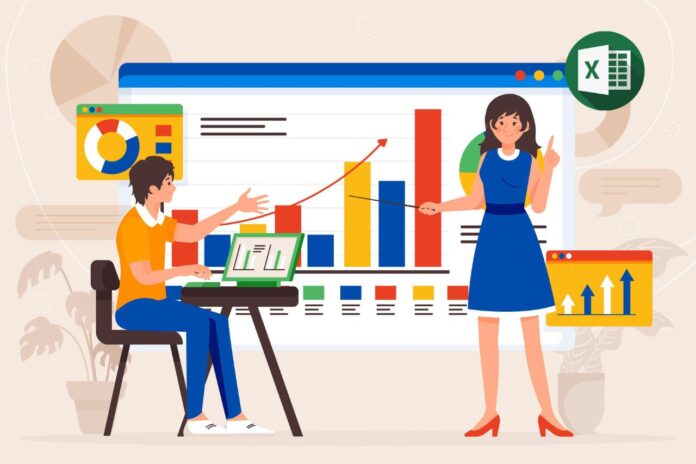Microsoft Excel is a powerful tool that millions of people around the world use every day to work with numbers and data. Whether it’s managing your budget, tracking expenses, analyzing sales data, or making charts, Excel helps you organize information and make sense of it all.
At its core, Excel is a spreadsheet program. That means it’s made up of a big grid of boxes called cells, arranged in rows and columns. You can type information into each cell, like numbers, text, or formulas and then use Excel’s built-in tools to calculate, sort, or display that data however you need.
Let’s take a look at what Excel does, how it works, and why it’s such a useful tool.
What is excel – Learn details excel body parts
How excel is display and set up
When you open Excel, you see a large sheet that looks like graph paper. This is called a worksheet. Each little box on the sheet is called a cell, and it’s identified by its position—like “A1” for the cell in column A and row 1.
You can have many worksheets in one Excel file, which is called a workbook. This lets you organize your information across different pages, sort of like having multiple tabs in a notebook.
Each worksheet gives you space to enter and manage all kinds of data, from simple shopping lists to complex financial models.
What You Can Do With Excel
1. Do Calculations Automatically
One of Excel’s biggest strengths is that it can do math for you. You don’t have to pull out a calculator, just type a formula into a cell, and Excel will give you the answer.
You can add, subtract, multiply, divide, and much more. For example:
=A1 + B1 adds the values in cells A1 and B1.
=SUM(A1:A10) adds all the values from A1 to A10.
Excel also has built-in functions that can save you time. These are ready-made formulas that do specific things, like:
AVERAGE() to find the average of numbers,
IF() to check if something is true or false,
VLOOKUP() to search for data in a table.
Even if you’re not a math expert, these tools make calculations easy.
2. Make Charts and Graphs
Data is easier to understand when it’s visual. Excel lets you turn numbers into charts and graphs with just a few clicks.
For example, you can:
Show trends over time with a line graph,
Compare items with a bar chart,
Break down a total with a pie chart,
Show relationships with a scatter plot.
These visuals help you spot patterns, explain data to others, and make decisions based on what you see.
3. Organize and Clean Up Data
Working with a lot of data can get messy. Excel has great tools to help keep everything in order.
You can:
Sort data (like putting names in alphabetical order),
Filter to show only certain rows (like customers from a specific city),
Use tables to keep your data structured,
Apply conditional formatting to highlight numbers that meet certain rules (like marking all scores below 50 in red).
These features make it easier to focus on the information that matters.
4. Automate Repetitive Tasks
If you do the same task over and over, Excel can help you save time by automating it. This is done using something called macros, which are small scripts written in a language called VBA (Visual Basic for Applications).
Let’s say you want to format a report the same way every week. Instead of doing it manually, you can record a macro once and then run it with a single click.
Automation is especially helpful in jobs that involve heavy data processing, like accounting or reporting.
5. Work With Others Easily
Excel also makes it easy to collaborate. If you save your file to OneDrive or SharePoint, you can share it with coworkers and even work on it at the same time.
You can leave comments, track changes, and protect certain cells so others can’t accidentally edit them.
Excel also connects well with other tools. You can import data from websites, databases, or other software. And it works smoothly with Microsoft Power BI, Word, Outlook, and more.
Where People Use Excel
Because Excel is so flexible, it’s used in almost every industry. Here are some examples
>In Finance and Accounting
Track income and expenses
Build financial models
Plan budgets
Prepare balance sheets and profit/loss reports
>In Business
Manage sales data
Monitor performance
Create dashboards
Organize client information
>In Education
Track grades and attendance
Plan lessons
Analyze research data
>In Data Analysis
Clean and prepare data for analysis
Summarize trends with pivot tables
Create reports and forecasts
>In Engineering and Science
Record experiment results
Run engineering calculations
Build technical charts
Basically, anywhere that involves numbers, lists, or analysis—Excel can probably help.
Why Learning Excel Matters
Knowing how to use Excel is a valuable skill. It can help you:
>Save time on tasks that would take hours by hand,
>Make better decisions using data,
>Communicate clearly with charts and reports,
>Stand out in job applications—many employers list Excel as a must-have skill.
Whether you’re a student, a professional, or just someone who likes being organized, Excel can help you work smarter.
Say Short About Excel
Excel is more than just a spreadsheet, it’s a powerful, flexible tool for working with data. It helps people organize information, do calculations, build reports, and visualize trends. With features like formulas, charts, data tools, and automation, Excel has become a go-to solution for millions around the world.
Even though it has some limitations, its ease of use and wide range of features make it incredibly useful in everyday life and work. As Excel continues to grow and evolve, learning how to use it well will only become more valuable.
If you can use Excel confidently, you’ll have a big advantage in almost any job that deals with data, organization, or planning.

